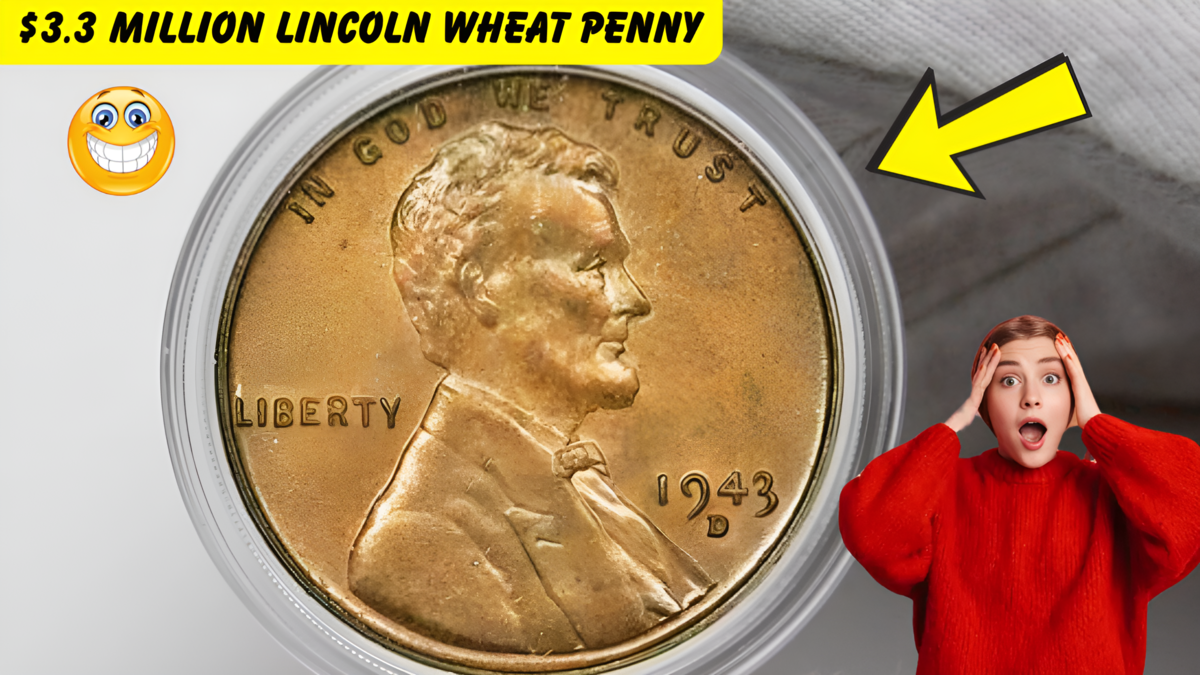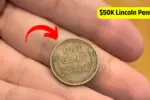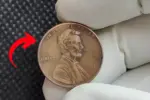The Lincoln Wheat Penny, first introduced in 1909, marked a significant change in U.S. coinage history. For the first time, a real person President Abraham Lincoln appeared on a circulating U.S. coin, replacing the traditional allegorical figures of Liberty and Lady Liberty. Designed by Victor D. Brenner, this penny features Lincoln’s profile on the front and two stalks of wheat on the reverse side, symbolizing prosperity and agriculture.
For nearly half a century, the Lincoln Wheat Penny was a familiar sight in the pockets of American citizens. However, after 1958, the design was replaced with the Lincoln Memorial, marking the end of the Wheat Penny era. Despite its widespread use, some versions of this coin have become valuable collector’s items, especially due to rare minting errors. One such coin recently sold for an astounding $3.3 million and it’s possible that one could still be hiding in your pocket!
The Rare 1943 Copper Lincoln Wheat Penny
The most famous and valuable Lincoln Wheat Penny is the 1943 copper variety. In 1943, due to the ongoing demands of World War II, the U.S. Mint switched from using copper to steel for the production of pennies, in order to conserve copper for military purposes. However, a small number of pennies were mistakenly struck on leftover copper planchets (the discs used to mint coins) from the previous year. This error created what has become one of the rarest and most coveted coins in U.S. history.
The 1943 copper penny has an estimated value of around $3.3 million for one in pristine condition, and only a handful of these rare pennies exist. As a result, these coins are sought after by collectors, and a single discovery could result in a massive payout for the lucky finder. But how can you tell if you have one of these incredibly rare pennies?
Identifying the 1943 Copper Lincoln Wheat Penny
The key to identifying the 1943 copper penny is understanding what sets it apart from the more common steel version. Here’s how to distinguish a genuine 1943 copper penny:
- Material: The regular 1943 penny was made from steel with a zinc coating to give it a silvery appearance. In contrast, the 1943 copper penny has the warm, reddish-brown color typical of copper. It is heavier as well due to its copper composition.
- The Date: The date on the penny is crucial. Only pennies dated 1943 could have been minted from either copper or steel. If your penny has the correct date and is made from copper, it could very well be the rare, valuable 1943 copper penny.
- Weight: A steel penny weighs about 2.7 grams, while a copper penny weighs closer to 3.1 grams. You can use a simple scale to check if your penny has the weight of copper.
If you suspect that you have a 1943 copper penny, it’s important to have it authenticated by a professional coin appraiser to confirm its rarity and value.
The Myth and the Reality of Finding a $3.3 Million Penny
The idea that a 1943 copper penny might still be circulating today might seem like a myth, but it’s very much a possibility. In fact, several of these pennies were found in circulation over the years, and they have fetched astronomical prices at auctions. The most recent record-breaking sale occurred when a 1943 copper penny was sold for $3.3 million at a public auction.
However, while it’s theoretically possible to stumble upon one of these rare pennies in your spare change, the chances of it happening are extremely slim. Most 1943 copper pennies have been removed from circulation by collectors or are locked away in private collections. But as with any rare find, the potential for discovery is what keeps numismatists and coin enthusiasts excited.
Other Valuable Lincoln Wheat Pennies
While the 1943 copper penny is the star of the show, other Lincoln Wheat Pennies are also highly valuable. Here are some additional rare and valuable Lincoln Wheat Pennies to watch out for:
- 1909-S VDB Penny: This coin is famous for the designer’s initials “VDB” on the reverse side. The “S” mintmark indicates it was minted in San Francisco, and it was produced in limited quantities. A well-preserved 1909-S VDB penny can fetch thousands of dollars.
- 1914-D Penny: With only about 1 million of these pennies minted, the 1914-D Lincoln Wheat Penny is another valuable find. The “D” mintmark indicates it was produced in Denver, and coins in high-grade condition can be worth a small fortune.
- 1922 No D Penny: This error coin has an interesting history. Due to a minting error, the “D” mintmark was left off the 1922 penny. This error coin is very rare and can be worth a significant amount, depending on its condition.
While the 1943 copper penny may be the most famous of the bunch, these other rare pennies are worth checking for, too.
How to Protect Your Coin Collection
If you’re serious about coin collecting or just want to keep an eye on your spare change for valuable pennies, here are some tips on how to protect and preserve your collection:
- Store Your Coins Properly: Use acid-free holders or coin flips to store your coins. Avoid touching the coins with your bare hands, as oils and dirt from your skin can damage the surface.
- Keep Coins in a Safe Place: Invest in a safe or lockbox to protect your collection from theft or damage. If you have rare coins, especially valuable ones like the 1943 copper penny, they should be kept in a secure location.
- Regularly Check Your Change: Keep an eye on your pocket change, especially when you receive pennies. Many rare coins are still in circulation, and you never know when you might come across a valuable piece.
- Consult with Professionals: If you believe you’ve found a rare coin, take it to a professional appraiser or a reputable coin dealer. They can verify its authenticity and help you understand its true value.
The Thrill of the Hunt – Is There a $3.3 Million Penny in Your Pocket?
Finding a $3.3 million penny might sound like a dream, but in the world of numismatics, it’s a possibility that keeps collectors on their toes. Whether it’s the 1943 copper penny or another rare Lincoln Wheat Penny, the thrill of discovering a coin with significant historical and monetary value is enough to make anyone excited.
While the odds of finding one of these rare pennies may be slim, the adventure of coin hunting is a rewarding experience in itself. The next time you check your pocket change, remember that you could be holding a valuable piece of history and if you’re lucky, it could be worth millions!
FAQs
What is the 1943 Copper Lincoln Wheat Penny?
The 1943 copper penny is a rare error coin made from copper instead of steel, and it is one of the most valuable pennies, worth up to $3.3 million.
How can I identify a 1943 Copper Lincoln Wheat Penny?
Look for a copper color, the 1943 date, and a weight of around 3.1 grams to distinguish it from the steel version.
Why was the 1943 Copper Lincoln Wheat Penny made?
It was created by mistake when leftover copper planchets from 1942 were used to mint a small number of pennies in 1943, despite the U.S. Mint’s plan to switch to steel for wartime production.
Are there other valuable Lincoln Wheat Pennies?
Yes, rare ones like the 1909-S VDB, 1914-D, and 1922 No D pennies are also highly valuable due to their low mintage and unique characteristics.
How can I protect my coin collection?
Store your coins in acid-free holders, keep them in a secure location, and consult professionals for appraisals to preserve their value.



